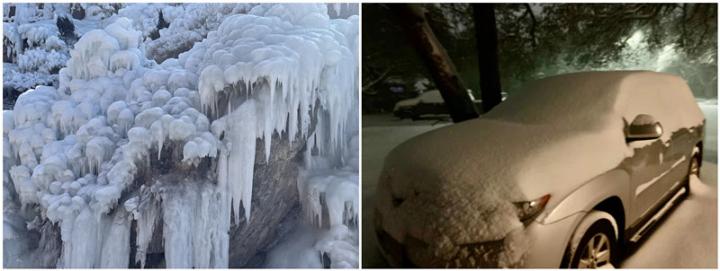
Credit: Fei Zheng/ Zong-Liang Yang
China is just one of many countries in the Northern Hemisphere having what researchers are calling an “extremely cold winter,” due in part to both the tropical Pacific and the Arctic, according to an analysis of temperatures from Dec. 1, 2020, to mid-January of 2021. A country-specific case study, the investigation potentially has far-reaching implications for predictions and early warnings to protect against harmful impacts, researchers said.
The results were published online, ahead of print, on Feb. 12 in Advances in Atmospheric Sciences.
“We are trying to explain why the countries in the Northern Hemisphere more frequently encounter the extremely cold events against a global warming background, and we chose the 2020-21 extremely cold winter in China as a case study,” said co-first author Fei Zheng, International Center for Climate and Environment Science (ICCES), the Institute of Atmospheric Physics (IAP) at the Chinese Academy of Sciences (CAS).
Since Dec. 1, 2020, the lowest temperatures in 58 cities, including Shanghai and Beijing, either broke or set records. On average, temperatures are at least one to two degrees Celsius below normal across the country, with some areas reporting temperatures as much as four degrees Celsius below average.
According to Zheng, two events thousands of miles from China are responsible: warming in the Arctic and cooling in the tropical Pacific, near the equator. Arctic warming results in melting ice, disrupting surface and ocean temperatures. La Niña, the cool phase of the tropical Pacific’s extreme climate cycles, drops ocean temperatures to -5 degrees Celsius and displaces atmospheric and global wind circulation.
“The synergistic effect of the warm Arctic, mostly induced by global warming, and the cold tropical Pacific, caused by La Niña, intensified the intrusions of cold air from polar regions into mid-high latitudes, which further influenced the cold conditions in China during the first half of winter 2020-21,” Zheng said. “This synergistic effect can be regarded as a necessary background for triggering the cold surges invading most countries in East Asia and North America.”
To forecast the evolution of La Niña in particular, the researchers used the ensemble prediction system developed at IAP, CAS. The system assesses the last 20 years of a selected climate event and offers a prediction of up to a year on how that event might evolve.
“The most recent ensemble forecast suggests that there is at least a 95% chance that La Niña will persist through the 2020-21 winter, with a potential transition to a neutral standing during the spring,” Zheng said, noting that there is still some uncertainty when it comes to winter predictions. “People should focus on weather forecasts and the latest predictions for atmospheric circulations to obtain the necessary date information and early warnings. We still need to pay attention to the possible large temperature fluctuations and increased snow and rainfall in China during the late winter.”
Researchers plan to further study the synergistic effect of extreme climate events through observation, climate simulation and data assimilation with the ultimate goal of improving seasonal predictions for countries in the Northern Hemisphere.
###
Zheng is also affiliated with the Collaborative Innovation Center on Forecast and Evaluation of Meteorological Disasters, Nanjing University of Information Science & Technology. Other contributors include co-first author Yuan Yuan, Yi-Hui Ding, Yu-Heng Zhao, Zong-Jian Ke and Xiao-Long Jia, National Climate Center, China; Ke-Xin Li, Yue Sun and Jiang Zhu, ICCES, IAP, CAS; Xiang-Hui Fang, Department of Atmospheric and Oceanic Sciences & Institute of Atmospheric Sciences, Fudan University; and Ji Wang, Beijing Municipal Climate Center. Li and Zhu are also affiliated with the University of Chinese Academy of Sciences.
The national Key R&D Program of China, the Key Research Program of Frontier Sciences, CAS and the National Natural Science Foundation of China funded this work.
Media Contact
Ms. Zheng Lin
[email protected]
Original Source
http://english.
Related Journal Article
http://dx.




